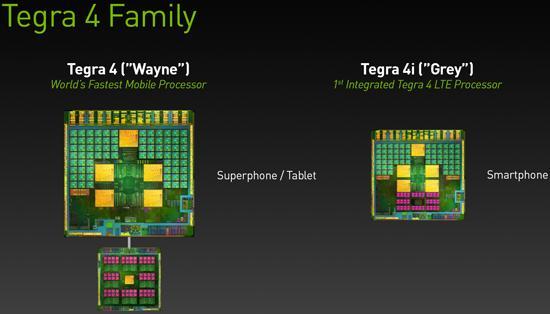
It's been less than a month since NVIDIA first took the wraps off of its new Tegra 4 processor, but today the company decided to add another chip to its roster. NVIDIA this morning officially announced the Tegra 4i, which is its first processor with integrated 4G LTE support. The Tegra 4i, previously known as Project Grey, is a 2.3GHz quad-core processor based on ARM's R4 Cortex-A9 CPU, and unsurprisingly, there's also a fifth companion core included that's meant to help conserve battery life during less-intensive tasks. NVIDIA says that the Tegra 4i features 60 custom GPU cores that can help it to power 1080p displays.
We've been hearing about NVIDIA's plans to offer a Tegra processor with integrated LTE support for some time now, so it's nice to see the company finally come through and officially announce the Tegra 4i. The Tegra 4i differs slightly from the Tegra 4 that we saw at CES, including 60 GPU cores rather than 72 and using a different ARM core, I'm sure that NVIDIA is pleased to have its own chip with baked-in LTE. Unfortunately, it's not yet clear what new hardware might feature the Tegra 4i processor or when we might see such devices come to market.
While there may be no word yet on when device manufacturers plan to launch new products with the Tegra 4i built in, that doesn't mean that we're without new hardware today. NVIDIA has also introduced Phoenix (shown below), its reference smartphone design that it hopes will will serve as a blueprint to help other device makers get Tegra 4i-powered products into the market. The Phoenix handset features a 5-inch 1080p display and 13-megapixel camera.
The final announcement made by NVIDIA today relates to photography. The firm announced that the Computational Photography Architecture that debuted with the Tegra 4 is now known as Chimera. This camera tech gives users access to features like always-on High Dynamic Range (HDR) for photos and video as well as support for HDR in panorama shots. Chimera also includes a tap-to-track capability that will lock the camera onto a chosen subject and follow it while either the subject or camera is moved. NVIDIA says that Sony's 13-megapixel Sony's Exmor RS IMX135 sensor and Aptina's AR0833 1/3" 8-megapixel sensor already include Chimera support. The company's full announcements can be found by hitting up the links at the bottom of this post.

Via NVIDIA (1), (2)